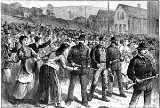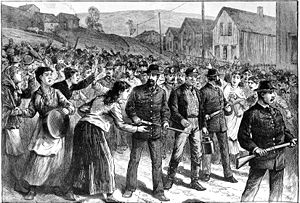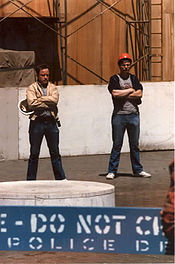
Strikebreaker
Encyclopedia

Strike action
Strike action, also called labour strike, on strike, greve , or simply strike, is a work stoppage caused by the mass refusal of employees to work. A strike usually takes place in response to employee grievances. Strikes became important during the industrial revolution, when mass labour became...
. Strikebreakers are usually individuals who are not employed by the company prior to the trade union
Trade union
A trade union, trades union or labor union is an organization of workers that have banded together to achieve common goals such as better working conditions. The trade union, through its leadership, bargains with the employer on behalf of union members and negotiates labour contracts with...
dispute, but rather hired prior to or during the strike to keep the organisation running. "Strikebreakers" may also refer to workers (union members or not) who cross picket lines to work.
Strikebreakers are employed worldwide, often occurring wherever workers go on strike or engage in related actions. However, strikebreakers are used far more frequently in the United States
United States
The United States of America is a federal constitutional republic comprising fifty states and a federal district...
than in any other industrialized country. The Mohawk Valley formula
Mohawk Valley formula
The Mohawk Valley formula is a document purportedly written by the president of the Remington Rand company James Rand, Jr., describing a plan for strikebreaking during the Remington Rand strike at Ilion, New York...
calls for the use of strikebreakers when dealing with striking employees.
International law
The right to strike is not expressly mentioned in any convention of the International Labor Organization (ILO); however, the ILO's Freedom of Association Committee established principles on the right to strike through ongoing rulings. Among human rights treaties, only the International Covenant on Economic, Social and Cultural RightsInternational Covenant on Economic, Social and Cultural Rights
The International Covenant on Economic, Social and Cultural Rights is a multilateral treaty adopted by the United Nations General Assembly on December 16, 1966, and in force from January 3, 1976...
contains a clause protecting the right to strike. However, like the Social Charter of 1961, the Covenant permits each signatory country to abridge the right to strike.
The ILO Committee on Freedom of Association and other ILO bodies have, however, interpreted all core ILO conventions as protecting the right to strike as an essential element of the freedom of association
Freedom of association
Freedom of association is the individual right to come together with other individuals and collectively express, promote, pursue and defend common interests....
. For example, the ILO has ruled that "the right to strike is an intrinsic corollary of the right of association protected by Convention No. 87."
The ILO has also concluded striker replacement, while not in contravention of ILO agreements, carries with it significant risks for abuse and places trade union freedoms "in grave jeopardy."
The European Social Charter of 1961 was the first international agreement to expressly protect the right to strike. However, the European Union
European Union
The European Union is an economic and political union of 27 independent member states which are located primarily in Europe. The EU traces its origins from the European Coal and Steel Community and the European Economic Community , formed by six countries in 1958...
's Community Charter of the Fundamental Social Rights of Workers permits EU member states to regulate the right to strike.
National laws

Europe
In most European countries, strikebreakers are rarely used. Consequently, they are rarely if ever mentioned in most European national labor laws. As mentioned above, it is left to the European UnionEuropean Union
The European Union is an economic and political union of 27 independent member states which are located primarily in Europe. The EU traces its origins from the European Coal and Steel Community and the European Economic Community , formed by six countries in 1958...
member states to determine their own policies.
- GermanyGermanyGermany , officially the Federal Republic of Germany , is a federal parliamentary republic in Europe. The country consists of 16 states while the capital and largest city is Berlin. Germany covers an area of 357,021 km2 and has a largely temperate seasonal climate...
has employment law that strongly protects worker rights, but trade unions and the right to strike are not regulated by statute. The Bundesarbeitsgericht (the Federal Labor Court of GermanyFederal Labor Court of GermanyThe Federal Labor Court is the court of the last resort for cases of labour law in Germany, both for individual labour law and collective labour law...
) and the Bundesverfassungsgericht (the Federal Constitutional Court of GermanyFederal Constitutional Court of GermanyThe Federal Constitutional Court is a special court established by the Grundgesetz, the German basic law...
) have, however, issued a large number of rulings which essentially regulate trade union activities such as strikes. Work councils, for example, may not strike at all, while trade unions retain an almost unlimited ability to strike. The widespread use of work councils, however, channels most labor disputes and reduces the likelihood of strikes. Recent efforts to enact a comprehensive federal labor relations law which regulates strikes, lockouts and the use of strikebreakers failed.
- United KingdomUnited KingdomThe United Kingdom of Great Britain and Northern IrelandIn the United Kingdom and Dependencies, other languages have been officially recognised as legitimate autochthonous languages under the European Charter for Regional or Minority Languages...
laws permit strikebreaking, and courts have significantly restricted the right of unions to punish members who act as strikebreakers.
Americas
- CanadaCanadaCanada is a North American country consisting of ten provinces and three territories. Located in the northern part of the continent, it extends from the Atlantic Ocean in the east to the Pacific Ocean in the west, and northward into the Arctic Ocean...
has federal industrial relations laws that strongly regulate the use of strikebreakers. Although many Canadian labor unions today advocate for even stronger regulations, scholars point out that Canadian labor law provides far greater protections for union members and the right to strike than American labor law (which has significantly influenced the development of labor relations north of the border). In QuebecQuebecQuebec or is a province in east-central Canada. It is the only Canadian province with a predominantly French-speaking population and the only one whose sole official language is French at the provincial level....
, the use of strikebreakers is banned, and companies may only attempt to remain open using managerial personnel.
- MexicoMexicoThe United Mexican States , commonly known as Mexico , is a federal constitutional republic in North America. It is bordered on the north by the United States; on the south and west by the Pacific Ocean; on the southeast by Guatemala, Belize, and the Caribbean Sea; and on the east by the Gulf of...
has a federal law which requires companies to cease operations during a legal strike, effectively preventing the use of strikebreakers.
- United States National Labor Relations ActNational Labor Relations ActThe National Labor Relations Act or Wagner Act , is a 1935 United States federal law that limits the means with which employers may react to workers in the private sector who create labor unions , engage in collective bargaining, and take part in strikes and other forms of concerted activity in...
appears to bar strikebreakers as an interference in the right to strike. However, the U.S. Supreme CourtSupreme Court of the United StatesThe Supreme Court of the United States is the highest court in the United States. It has ultimate appellate jurisdiction over all state and federal courts, and original jurisdiction over a small range of cases...
held in NLRB v. Mackay Radio & Telegraph Co.NLRB v. Mackay Radio & Telegraph Co.NLRB v. Mackay Radio & Telegraph Co. 304 U.S. 333 is a 7-0 decision by the United States Supreme Court which held that workers who strike remain employees for the purposes of the National Labor Relations Act . The Court granted the relief sought by the National Labor Relations Board, which sought...
, 304 U.S. 333Case citationCase citation is the system used in many countries to identify the decisions in past court cases, either in special series of books called reporters or law reports, or in a 'neutral' form which will identify a decision wherever it was reported...
(1938) that an employer may not discriminate on the basis of union activity in reinstating employees at the end of a strike. The ruling effectively encourages employers to hire strikebreakers, so that the union loses majority support in the workplace when the strike ends. The Mackay Court also held that employers enjoy the unrestricted right to permanently replace strikers with strikebreakers.
Asia
- JapanJapanJapan is an island nation in East Asia. Located in the Pacific Ocean, it lies to the east of the Sea of Japan, China, North Korea, South Korea and Russia, stretching from the Sea of Okhotsk in the north to the East China Sea and Taiwan in the south...
ese labor law significantly restricts both an employer's and a union's ability to engage in labor disputes. Japanese labor law highly regulates labor relations to ensure labor peace and channel conflict into collective bargaining, mediation and arbitration. Japanese labor law bans the use of strikebreakers.
- South KoreaSouth KoreaThe Republic of Korea , , is a sovereign state in East Asia, located on the southern portion of the Korean Peninsula. It is neighbored by the People's Republic of China to the west, Japan to the east, North Korea to the north, and the East China Sea and Republic of China to the south...
bans the use of strikebreakers, although the practice remains common.
Synonyms
In the early 20th century, strikebreaking was known as "black-legging"—a term borrowed from the RussiaRussia
Russia or , officially known as both Russia and the Russian Federation , is a country in northern Eurasia. It is a federal semi-presidential republic, comprising 83 federal subjects...
n socialist
Socialism
Socialism is an economic system characterized by social ownership of the means of production and cooperative management of the economy; or a political philosophy advocating such a system. "Social ownership" may refer to any one of, or a combination of, the following: cooperative enterprises,...
movement.
See also
- Molly MaguiresMolly MaguiresThe Molly Maguires were members of an Irish-American secret society, whose members consisted mainly of coal miners. Many historians believe the "Mollies" were present in the anthracite coal fields of Pennsylvania in the United States from approximately the time of the American Civil War until a...
- "The Scab" by Jack London (attributed)
- Blackleg MinerBlackleg MinerBlackleg Miner is a 19th-century English folk song, originally from Northumberland ....
(song)

